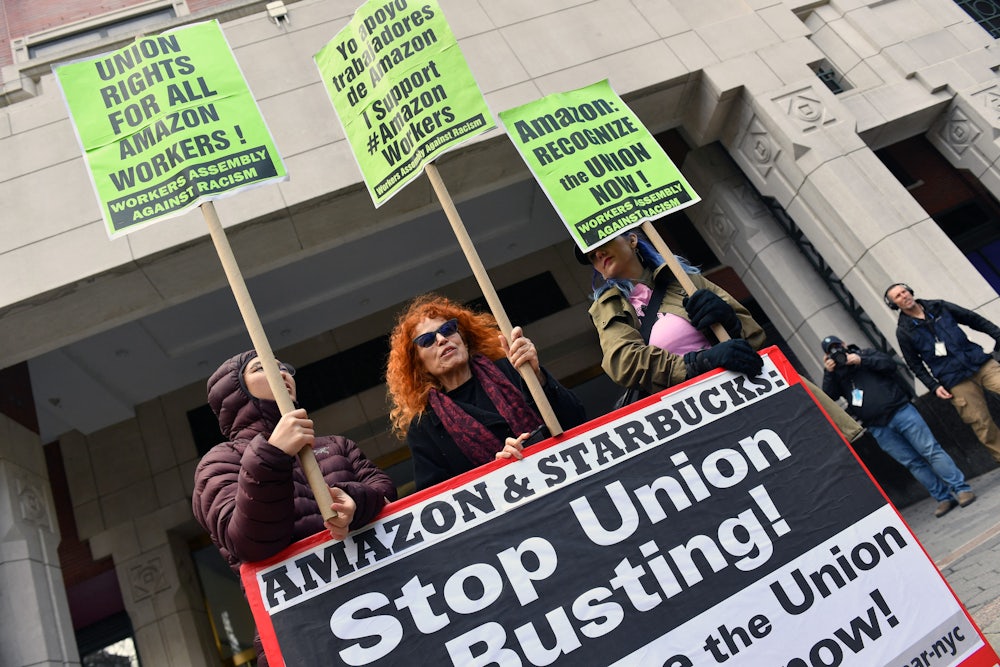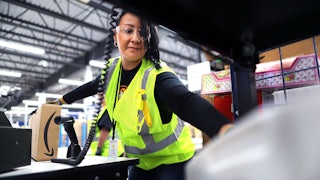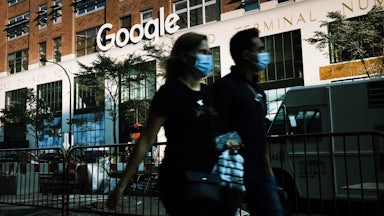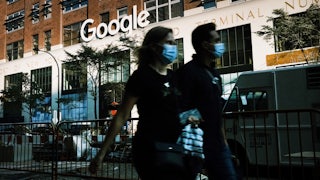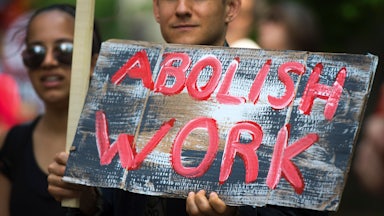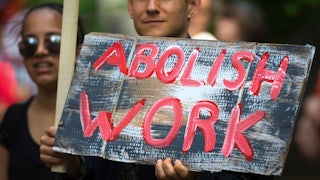In nearly every major organizing drive it becomes a point of contention that managers compel workers to attend meetings in which they propagandize against the evils of union representation. Workers who favor unionization, by contrast, seldom are allowed even to leaflet on company property. “Captive audience” meetings were an issue in last week’s vote to unionize Amazon’s JFK8 warehouse in Staten Island—the first union victory ever at an Amazon facility in the United States—and they were an issue in the earlier, unsuccessful attempt last year by the Retail, Wholesale and Department Store Union to organize Amazon’s BHM1 warehouse in Bessemer, Alabama. (Ballots are still being counted in a follow-up election held on March 31, but management appears to have eked out a narrow victory.)
Captive audience meetings are by definition coercive; if they weren’t, attendance would be optional and workers who didn’t attend wouldn’t have to worry about getting the boot. But for seven decades courts have judged them to be perfectly legal. The Protecting the Right to Organize Act, which in March 2021 cleared the House 225–206 (with five Republicans voting in favor!) would outlaw captive audience meetings.
The PRO Act will have a long wait in the Senate, but in the meantime, Jennifer Abruzzo, general counsel of the National Labor Relations Board and arguably the most powerful labor official in the Biden administration, is inviting the NLRB to consider that even under current law, captive audience meetings aren’t legal.
What are captive audience meetings like? For one thing, they’re mandatory. “Captive audience meetings are well-named,” John Brady, a former nurse at Backus Hospital in Norwich, Connecticut, says in a video posted by the Connecticut AFL-CIO. You can be fired for not attending; you can be fired for leaving early; you can be fired even for asking a question. “When I would try to speak up and counteract what was being said,” Ally Dube—a former employee at M&J Bus, a school bus company based in Old Saybrook—says in the same video, “he would be like, Shut up, this is not your floor. This is my meeting.”
Two years ago, Lauren Kaori Gurley of Vice obtained a 23-minute video of a captive audience meeting held by No Evil Foods, a North Carolina–based seller of vegan products whose website says its mission is “to empower people to make positive changes for themselves” and to address “issues like food insecurity, economic justice, and climate change.” (In my experience, the more a company promotes self-actualization in its literature, the more aggressively it works to bust unions.) The No Evil Foods video quickly became a YouTube classic.
In the video, company co-founder Mike Woliansky tells his workers that if the United Food and Commercial Workers is successful in organizing the plant, that will impede the company’s ability to “save lives” and “change the world.” Woliansky tells the workers that the UFCW is “a huge organization with high-paid executives and a history of scandal and supporting slaughterhouses.”
The accusation that unions are scandal-plagued organizations that soak the rank and file for union dues lavished on top managers who light cigars with $100 bills is standard fare in such presentations. So is the threat that unionization would bankrupt the company. In his speech, Woliansky chokes up as he talks about taking out a second mortgage on his house to purchase equipment for the plant. The UFCW lost the vote, 43–15.
Captive audience meetings are one of many sketchy management practices that didn’t acquire legal sanction until the passage, in 1947, of the anti-union Taft-Hartley Act. As passed in 1935, the National Labor Relations Act—popularly known as the Wagner Act—was silent on the matter, but the NLRB initially interpreted the law’s sanctions against management coercion to mean captive audience meetings were illegal. Under the original law, it wasn’t even clear that employers were free to voice an opinion about whether to unionize. Taft-Hartley, which amended the Wagner Act, clarified that they were, provided they included no “threat of reprisal or force or promise of benefit” to vote aye or nay. The NLRB, in its 1948 decision in Babcock v. Wilcox, interpreted that to mean captive audience meetings were legal. Craig Becker, an NLRB board member under President Barack Obama and now general counsel of the AFL-CIO, argued in a 2011 dissent that that was a legal wrong turn. Now Abruzzo is saying she agrees. She is, Becker told me, “reversing decades of precedent which isn’t very deep in its reasoning.”
In a memorandum released Thursday, Abruzzo argues that captive audience meetings violate the Wagner Act because they “inherently involve an unlawful threat that employees will be disciplined or suffer other reprisals if they exercise their protected right not to listen to such speech.” In 1969, Abruzzo notes, the Supreme Court affirmed in NLRB v. Gissel Packing Co. that employers enjoyed the right to free speech but that that right did not extend to threats against employees engaged in union organizing. “Forcing employees to listen” to employers inveigh against unions “under threat of discipline,” Abruzzo writes, is coercive and therefore illegal. That happens in captive audience meetings, Abruzzo writes; it also happens when an employee is “cornered by management while performing their job duties.” She therefore urges the NLRB to “adopt sensible assurances that an employer must convey to employees in order to make clear that their attendance is truly voluntary.”
It will probably be about a year before the NLRB decides whether to adopt this position. (Among other things, it needs to find a test case and solicit briefs on both sides of the matter.) If the NLRB adopts Abruzzo’s position, there may be one or two downsides. “It hasn’t always been universally the case that organizers thought this would be a good idea,” Becker told me, because once attendance is voluntary at company anti-union meetings, management may keep track of those who don’t attend, conclude they’re pro-union, and then find other reasons to harass them. So “it’s a little bit of a double-edged sword.” Still, Becker remains strongly in favor.
Another consideration is that captive audience meetings can occasionally be an opportunity for employees who openly support unionization—whom management often forbids from attending the meetings—to disrupt the proceedings and draw attention to their position. In These Times spoke earlier this week with two impressively daring employees at Amazon’s JFK8 warehouse who adopted this tactic. “We went in,” explained Justine Medina,
marched in, made a bit of a disruption, sat down, and then we would interrupt with questions, and answer [other] questions.… A few of us were thinking, “Are they going to call the cops?” Other workers were whispering about whether they were going to call the cops. And then eventually, they knew we weren’t leaving so they ended that session.…
By the final weeks leading up to the vote, they started kicking people out. They said, “You’re not allowed in if you’re not supposed to be here.” We would try to do it anyway.… A lot of workers themselves who weren’t necessarily “yes” voters or were on the fence would raise their hands and say, “Why won’t you let someone from the union speak up about what’s going on? Why don’t you let them say their side?”
If you’re tempted to try this, you should probably first consult a lawyer and also make a plan for what you’ll do should you suddenly find yourself out of work.
Outlawing captive audience meetings wins the argument. Requiring employees to attend scare sessions about unionization is clearly a form of intimidation, one that management won’t give up happily. The Chamber of Commerce hasn’t weighed in yet, but it won’t be pleased. Speaking for it, as is her wont, Representative Virginia Fox of Virginia, ranking Republican on the House Education and Labor Committee (which, whenever Republicans are in the majority, gets its name changed to the Education and the Workforce Committee), said in a written statement that if the NLRB chooses to “silence job creators, the consequences will be disastrous.”
Harold Meyerson of The American Prospect, who has a good Abruzzo profile in the current issue, disagrees. He wrote on Thursday that the memo confirms Abruzzo’s status as “the most potent champion of worker rights that the government has seen in a great many years.” I’ll go with Meyerson on this one. Abruzzo is taking a bold and righteous stand for American workers.
